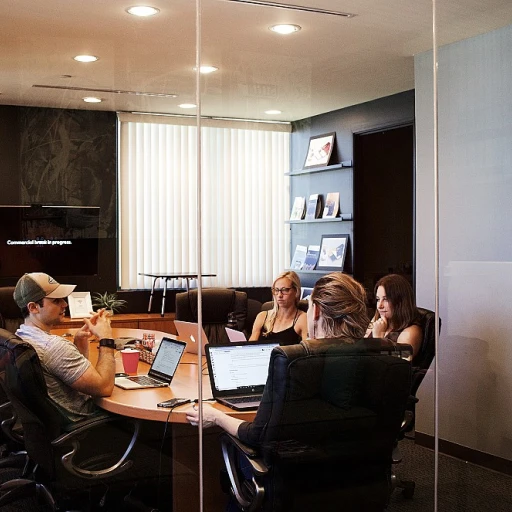
Understanding Rental Space Metrics
Decoding Key Space Metrics
Understanding how to effectively measure and utilize rental space is crucial for office managers in the UK. To start, let's explore some of the essential metrics. These will help identify how efficiently your office space is being used and what potential improvements could be made.
Gross Leasable Area (GLA) is a fundamental concept in the world of commercial real estate. It refers to the total floor area designed for tenant occupancy, including both private and common areas. The GLA is vital for calculating rental rates and can significantly affect the potential rent yield of your property.
Another important metric is the Net Leasable Area, which focuses on the actual rentable area of the office, excluding any common real estate spaces like stairwells and lifts. A clear understanding of both these metrics, as per the BOMA standards, helps determine the real estate's efficiency in generating revenue.
Moreover, by analyzing the Gross Potential Rent, managers can envisage the maximum potential income if the building's leasable space was fully occupied at market rates, minus common area deductions. This can be complemented by examining the Area Commercial metrics, which provide insights into the commercial property's square footage, hence assisting in effective lease negotiations.
For more insights on enhancing office space efficiency, you might want to explore tools that can aid you in optimizing these metrics and improve overall management of your office. Learn more about relevant resources here.
Evaluating Current Space Utilisation
Assessing Current Usage of Office Spaces
To maximise the efficiency of your rental space, it's crucial to evaluate how your current office layout is being utilised. Understanding the balance between rentable area and non-leasable parts such as corridors and other common areas is essential. A deep dive into your existing floor area can reveal potential for optimisation that is often overlooked in daily operations. Start by measuring the gross leasable area (GLA). This metric captures the total space available for tenants to occupy and is critical when driving rental rates. If the proportion of net leasable space is lower than expected, it might be time to reconsider how your property is partitioned. Are there common areas that unnecessarily reduce the square footage available for lease? Moreover, reviewing the utilisation of commercial and real estate assets involves paying attention to BOMA standards, which provide detailed guidelines on evaluating rentable area. Ensuring that your spaces meet these standards can enhance the attractiveness of your building to potential tenants. It's beneficial to compare your current floor usage with scaling commercial properties in similar estates. This comparison identifies discrepancies and opportunities for better allocation of areas. Don't forget to factor in the financial aspect, such as loans and financing obligations linked to your commercial property. Understanding the gap between your gross potential rent and actual earnings can spotlight inefficiencies. By addressing these issues, you can potentially increase the gla commercial and gross return on your investment, thereby making your property more appealing to current and future tenants.Strategies for Optimising Space
Practical Approaches to Boost Space Utilisation
Maximising the efficiency of rental space within UK offices involves several key strategies. When evaluating the use of space, it's essential to consider both the gross leasable area (GLA) and the net leasable area. By assessing these metrics, businesses can identify underused areas and devise plans to optimise them. To improve the usage of space, consider the following approaches:- Reassess Layout: Start by evaluating the current floor plan. A new arrangement could better accommodate both the current and future needs of the office space, ensuring common areas are efficiently integrated.
- Flexible Workspaces: Implementing flexible workspaces can enhance gross potential rent by making the most out of every square foot. This can lead to a better balance of workspace for both tenants and property managers.
- Subleasing: In cases where the leasable area is larger than needed, consider subleasing sections of the office. This not only maximises utilisation but also mitigates the burden of rental rates.
- Utilise BOMA Standards: Incorporating building owners and managers association (BOMA) standards can assist in determining the most efficient mix of commercial property usage, helping to limit wastage and potential loss.
Balancing Cost and Space Needs
Finding the Sweet Spot Between Cost and Space Efficiency
When it comes to managing office rentals in the UK, ensuring a balance between cost and space needs is crucial for office managers. The key is to make the most of the rentable area while maintaining a budget-friendly lease agreement. Prioritizing gross leasable area (GLA) can optimize space usage, especially in commercial property settings where every square foot counts. Office managers must consider the gross potential rental rates of their commercial real estate and the potential rents achievable based on their current floor area. This focus can aid in making informed decisions about how much space to lease from a building's GLA commercial offerings.Practical Approaches to Better Space Management
- Evaluate the Space Needs of Current Tenants: Begin by understanding the requirements of all tenants in your commercial premises. Identifying their needs can guide decisions about reallocating square footage or transforming common areas.
- Leverage BOMA Standards: Utilizing Building Owners and Managers Association (BOMA) standards can help in accurately calculating leasable area and ensure that you have clarity on the net leasable space available.
- Adopt Flexible Leasing Options: Offering flexible leasing terms can maintain a balance between gross potential income and tenant satisfaction. This adaptability can also allow tenants to scale up or down based on their season-related needs.
- Look into Space-Sharing Solutions: Encourage collaboration between tenants to share common areas, potentially introducing co-working schemes to maximize building usage without increasing costs for individual renters.
Exploring Financing and Loan Options
Examining financing options can also alleviate cost pressures on rental spaces. Loans can be structured to accommodate needs like space renovation or expansion. Considering this, tenants and property managers can unlock potential improvements in the leasable area without stretching financial limits. In conclusion, office managers should focus on achieving the optimal balance of cost efficiency and practical space utilization. Through strategic planning and a clear understanding of their commercial lease's financial aspects, they can better serve the needs of all stakeholders involved.Technology's Role in Space Management
The Role of Innovative Solutions in Optimising Office Space
Efficient space management in UK offices has become increasingly important. As businesses aim to get the most out of their rental spaces, technology offers promising solutions for optimising areas such as the gross leasable area (GLA) and common areas. To effectively manage and utilise office space, technology can provide insights and real-time data on floor area usage. This aids in maximising the rentable area while taking into consideration commercial property dynamics. For example, smart sensors and workplace management systems can track the usage of each square footage, offering detailed analytics about potential rent yield versus actual use. Additionally, implementing cloud-based platforms allows businesses to align their real estate strategies with their operational goals. These platforms can integrate gross potential rental rates with tenant demands, providing a clear outlook on space management efficiency. In commercial real estate, adopting software that adheres to BOMA standards can refine space calculations, enabling accurate assessments of area net usage and net leasable space. This ensures transparency and enhances trust with tenants by clearly defining rentable and shared areas. Integrating these technologies within an estate not only optimizes building operations but also leverages valuable insights to generate cost efficiencies. When aligned with financial strategies, such as loans and financing models, companies can effectively balance rental obligations with their leasing agreements. These technological advancements create a conducive environment for strategic decision-making, potentially leading to optimized lease agreements and improved tenant satisfaction.Case Studies from UK Companies
{"Practical Experiences from the UK
Many UK companies have successfully maximised the efficiency of their rental spaces, turning challenges into opportunities. By leveraging industry standards such as BOMA standards and effective floor area management, they have set benchmarks for others to follow.
Case 1: Commercial Real Estate Firm in London
A leading commercial real estate firm in London adapted their leasable area strategy to maximize potential rent returns. By carefully analyzing their gross leasable area (GLA) and implementing strategic space optimization measures, they significantly improved rental rates. This firm focused on reducing common areas and enhancing net leasable space, resulting in more appealing offers for tenants.
Case 2: Tech Company in Manchester
A tech company based in Manchester successfully balanced their cost and space needs by focusing on flexible office layouts. Instead of locking into rigid lease agreements, they explored options that allowed them to adjust their space as needed, based on tenant demands. This approach not only optimized the gross leasable area but also opened avenues for potential financing opportunities through innovative lease structures.
Case 3: Retail Chain in Birmingham
A retail chain successfully utilized their floor area by opting for a mixed-use commercial property strategy. By integrating retail and office spaces, they maximized their rentable area to accommodate a diverse tenant mix. This strategy not only enhanced the property's value but also streamlined area GLA management, proving beneficial for both retail and office needs within the same building.
These cases highlight the diverse strategies employed across the UK’s real estate landscape. Whether through improving Gross Potential Rent (GPR) or enhancing area net efficiency, these companies have demonstrated that with careful planning and execution, optimising space can significantly impact the bottom line. Understanding these implementations can provide valuable insights for any company looking to enhance their real estate efficiency.













